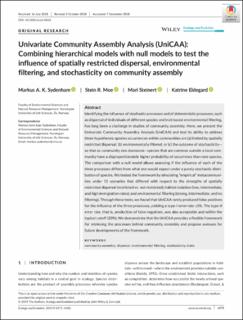| dc.contributor.author | Sydenham, Markus A. K. | |
| dc.contributor.author | Moe, Stein Ragnar | |
| dc.contributor.author | Steinert, Mari | |
| dc.contributor.author | Eldegard, Katrine | |
| dc.date.accessioned | 2020-12-01T15:54:59Z | |
| dc.date.available | 2020-12-01T15:54:59Z | |
| dc.date.created | 2019-01-14T10:10:50Z | |
| dc.date.issued | 2019 | |
| dc.identifier.citation | Ecology and Evolution. 2019, 9(3), 1473-1488. | en_US |
| dc.identifier.issn | 2045-7758 | |
| dc.identifier.uri | https://hdl.handle.net/11250/2711298 | |
| dc.description.abstract | Identifying the influence of stochastic processes and of deterministic processes, such as dispersal of individuals of different species and trait‐based environmental filtering, has long been a challenge in studies of community assembly. Here, we present the Univariate Community Assembly Analysis (UniCAA) and test its ability to address three hypotheses: species occurrences within communities are (a) limited by spatially restricted dispersal; (b) environmentally filtered; or (c) the outcome of stochasticity—so that as community size decreases—species that are common outside a local community have a disproportionately higher probability of occurrence than rare species. The comparison with a null model allows assessing if the influence of each of the three processes differs from what one would expect under a purely stochastic distribution of species. We tested the framework by simulating “empirical” metacommunities under 15 scenarios that differed with respect to the strengths of spatially restricted dispersal (restricted vs. not restricted); habitat isolation (low, intermediate, and high immigration rates); and environmental filtering (strong, intermediate, and no filtering). Through these tests, we found that UniCAA rarely produced false positives for the influence of the three processes, yielding a type‐I error rate ≤5%. The type‐II error rate, that is, production of false negatives, was also acceptable and within the typical cutoff (20%). We demonstrate that the UniCAA provides a flexible framework for retrieving the processes behind community assembly and propose avenues for future developments of the framework. | en_US |
| dc.language.iso | eng | en_US |
| dc.rights | Attribution-NonCommercial-NoDerivatives 4.0 Internasjonal | * |
| dc.rights.uri | http://creativecommons.org/licenses/by-nc-nd/4.0/deed.no | * |
| dc.title | Univariate Community Assembly Analysis (UniCAA): Combining hierarchical models with null models to test the influence of spatially restricted dispersal, environmental filtering, and stochasticity on community assembly | en_US |
| dc.type | Peer reviewed | en_US |
| dc.type | Journal article | en_US |
| dc.description.version | publishedVersion | en_US |
| dc.source.pagenumber | 1473-1488 | en_US |
| dc.source.volume | 9 | en_US |
| dc.source.journal | Ecology and Evolution | en_US |
| dc.source.issue | 3 | en_US |
| dc.identifier.doi | 10.1002/ece3.4868 | |
| dc.identifier.cristin | 1655904 | |
| cristin.unitcode | 192,14,0,0 | |
| cristin.unitname | Miljøvitenskap og naturforvaltning | |
| cristin.ispublished | true | |
| cristin.fulltext | original | |
| cristin.qualitycode | 1 | |

